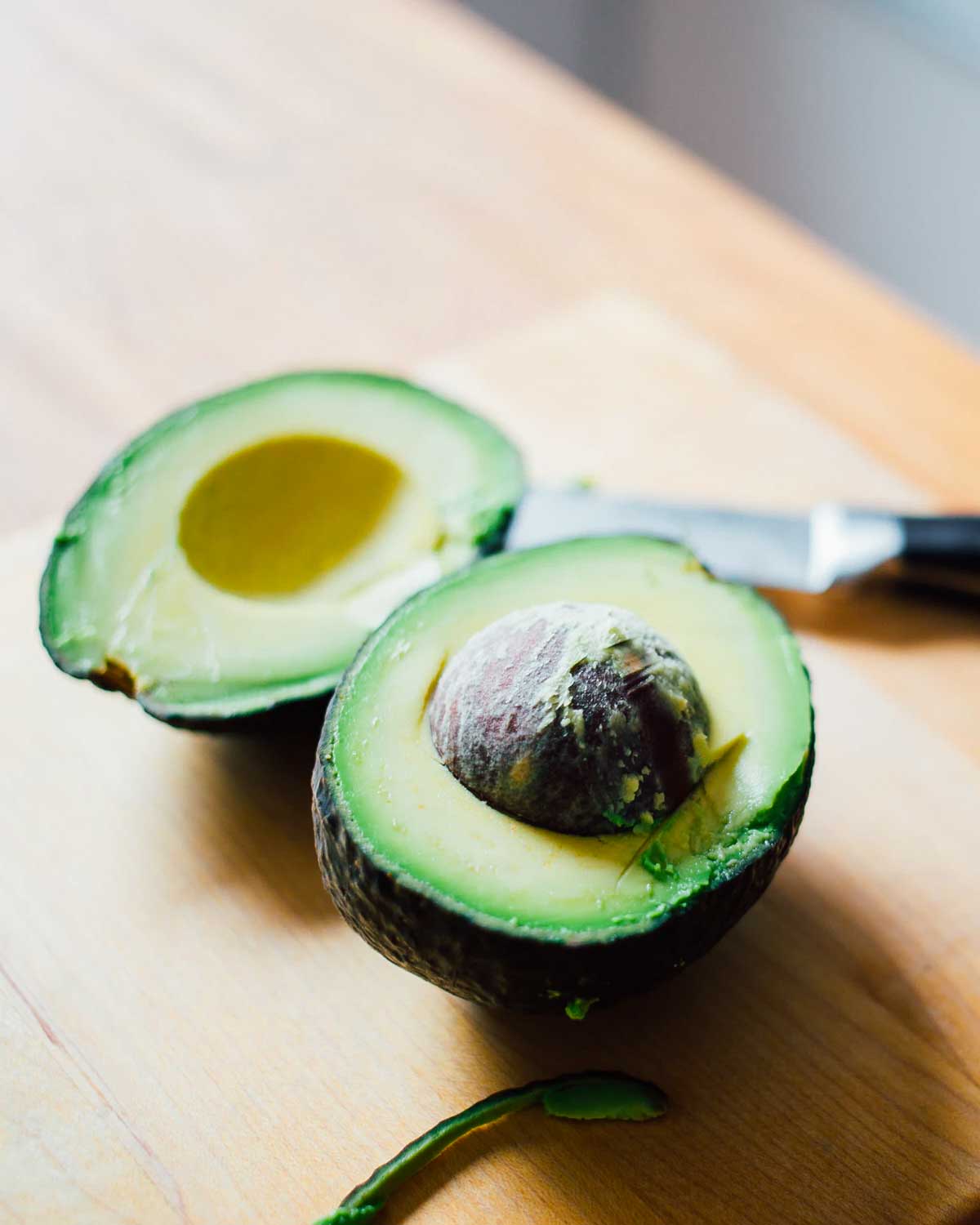
I have a weakness for avocados. I eat them daily…correction…I DEVOUR them daily. Scooped straight from the shell with a spoon. As a cradle for seafood salad. In smoothies. Grilled. You name it. I can always find a way to sneak some avocado into my day.
The one thing I haven’t figured out is how to keep extra avocado from turning brown.
I know I can squeeze lemon juice on avocado slices, cover them with plastic wrap and pop them in the fridge for later in the day. I also know I can place a whole ripe avocado in the fridge and it will keep longer. But what about those precious leftover halves? How do you store them for later without having them turn an unsightly brown?
During the last several months, I repeatedly bumped into the idea that blanching avocados can keep them from turning brown. I first heard of the notion in November. An email showed up in my inbox with the subject line, “Why Boiling an Avocado Keeps It Green for Hours.” I didn’t think much of it at the time, but when the topic randomly popped up in a conversation a few weeks later, I started to wonder if there was something to it. A little internet sleuthing revealed that blanching avocados was actually a thing. I discovered articles dating back to 2012 and from as far away as South Africa. Could blanching the delicious green orbs whole significantly delay browning after they’re cut? Curious, I set out to see if it really works.
The Science-y Part
Okay, a little science is required to understand what’s happening. I needed to answer two questions: Why do avocados turn brown? And how could blanching possibly stall this?
Turns out avocados contain an enzyme under their skin called polyphenol oxidase (PPO). Once an avocado is cut, the enzyme becomes exposed to air and a chemical reaction occurs. The enzyme (PPO) reacts with oxygen in the air and, as a result, the flesh of the avocado turns brown. This is known as “enzymatic browning.”
Blanching delivers heat and heat deactivates polyphenol oxidase which, in turn, means less browning. So, the theory goes, blanching whole avocados before they’re cut should transfer heat to the enzyme and deactivate it, thereby slowing the browning process.
Actually, what my research revealed is that PPO activity is slightly decreased at 140°F (60°C). We know that the blanching process will provide the heat we need to move through the skin of the avocado, from outside the fruit to inside the fruit. What we don’t know is exactly how long to blanch our fruits. The experiments I’ve read recommend blanching times that range from for 10 to 20 seconds. Let’s see.
The avocado jacuzzi
I filled a large pan with water and brought it to a boil. Then I took a piece of paper, drew a line down the middle of it, and noted on each side which avocado was which. (This may seem silly, but I am fully capable of getting busy and forgetting which one was on which side. Don’t laugh.)
Everything prepped, I was ready to test.
Testing. Testing.
I placed the avocado that wasn’t being blanched on my cutting board and ignored it for the moment. Using a slotted spoon, I carefully lowered the second fruit into the avocado jacuzzi and blanched it for 10 seconds. Then I removed the avocado from said jacuzzi and plunged it into the ice bath. After 5 minutes in the bath, I pulled the avocado out and dried it off.
Next, I cut the avocados in half, removed their pits, and placed each in their assigned seating. I started the timer and monitored the avocados for 8 hours, checking on them every 30 minutes.
You’ve guac to be kidding me
The first hour went by and a few brown spots appeared on both avocados.
The same thing happened during the second hour.
As the third hour went by, a few more spots appeared on both and a bruise presented itself on the not-blanched fruit. “It’s still early,” I thought. “Be patient. It’ll happen.”
By the fourth hour, the flesh on both had started to turn distinctively brown. “Both avocados… the same?! What’s happening here?” I wondered.
Hours five thru eight? More muddled brown grossness ON BOTH AVOCADOS! “Where’s the green?” I asked aloud.
Bottom line: Blanching doesn’t work
It didn’t work. The magic didn’t happen. I mean, maybe the blanched avocado was the slightest bit less brown…but it wasn’t enough for us to say the great avocado conundrum had been solved.
Why weren’t there any discernible differences? Did I do something wrong? I went back over everything in my head – blanch, ice bath, check every 30 minutes. Why didn’t it work?
Maybe it was because they were organic! Could that be? I had to know.
A few days later and two conventional avocados in hand, I repeated the experiment. As before, one fruit skipped the spa treatment and went straight to the cutting board. The other spent time in the avocado jacuzzi (20 seconds this time) and then took an ice bath for 5 minutes. Again, I monitored the avocados for 8 hours, checking on them every 30 minutes.
Time passed. Spots appeared. More time passed. Both avocados started to brown evenly. Oh no… I watched and watched and it was as if the avocados were evenly matched sprinters racing to the eighth hour. Why? They were neck and neck. Even browning. Even browning. Even browning all the way to the end!
Everything will be all ripe
A few good things did come out of this. My inner food geek got to blanch avocados and learn a little seventh-grade science-y stuff in the process. Although some sources say you can leave the avocados in the boiling water a little longer, I don’t recommend it. You run the risk of altering their creamy, luscious avocado-ness. Blanching, I’ve decided, isn’t worth the effort.
Second, guacamole! Not wanting to waste the avocados, I turned my experiments into small batches of my go-to nosh for slightly less than perfect avocados. And that’s never a bad thing. I also learned that brown spots on a fresh avocado are perfectly safe, if not always desirable, to eat. (How did I not know this?!) They may taste slightly bitter, but they won’t hurt you. Armed with this knowledge, future me won’t be doing any more scraping. No. I’ll be mixing in those brown spots, and that means more avocado and less food waste for me.
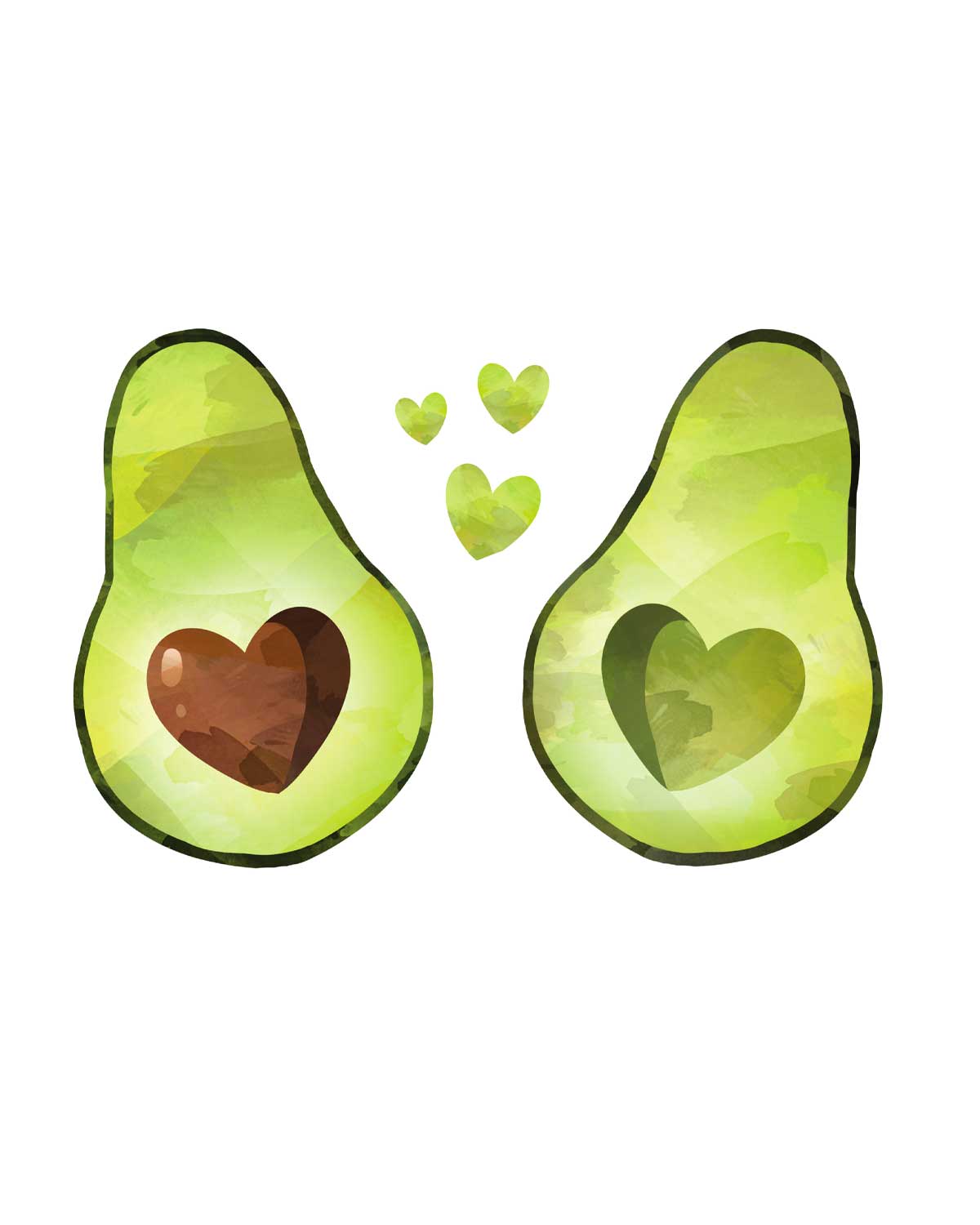
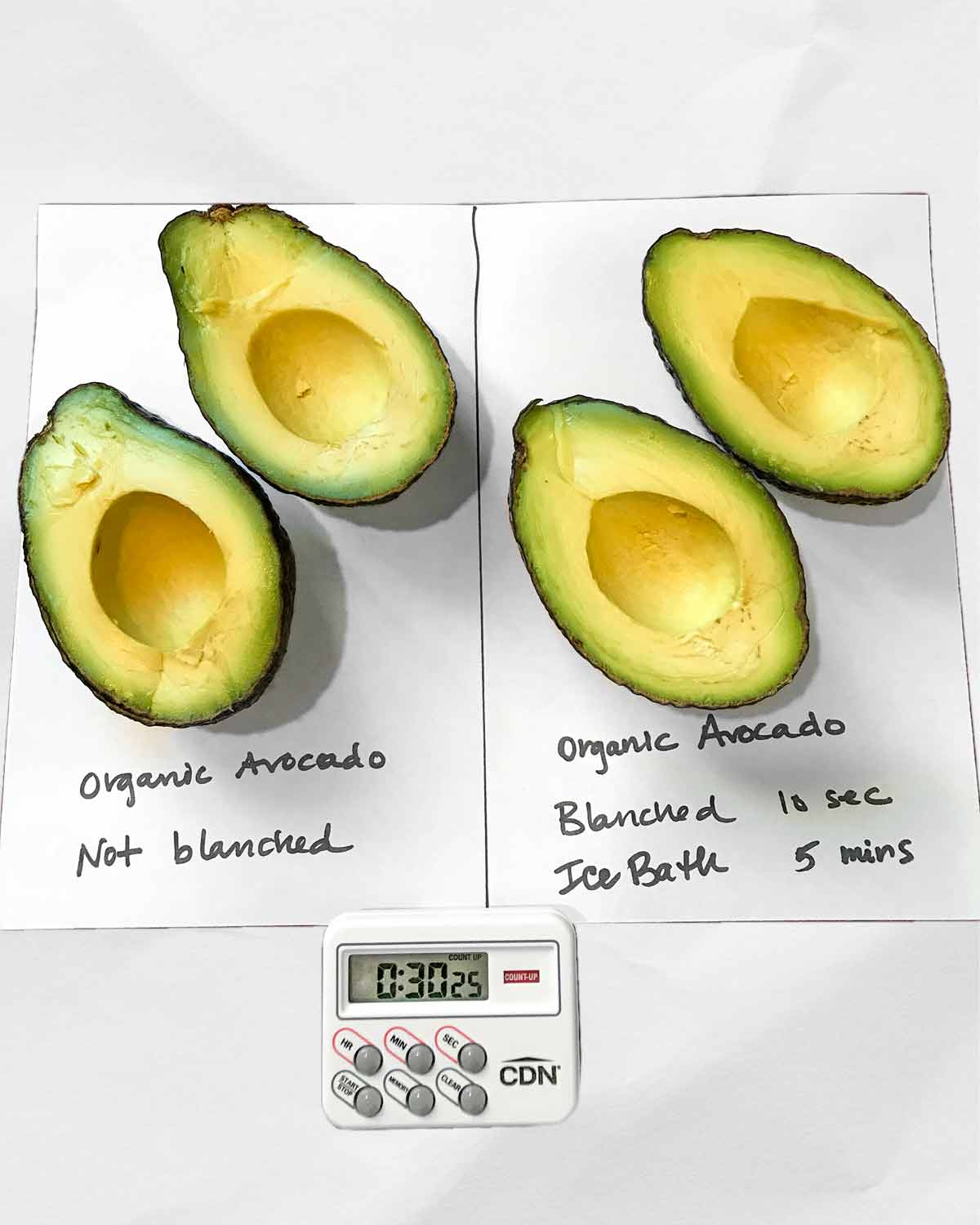
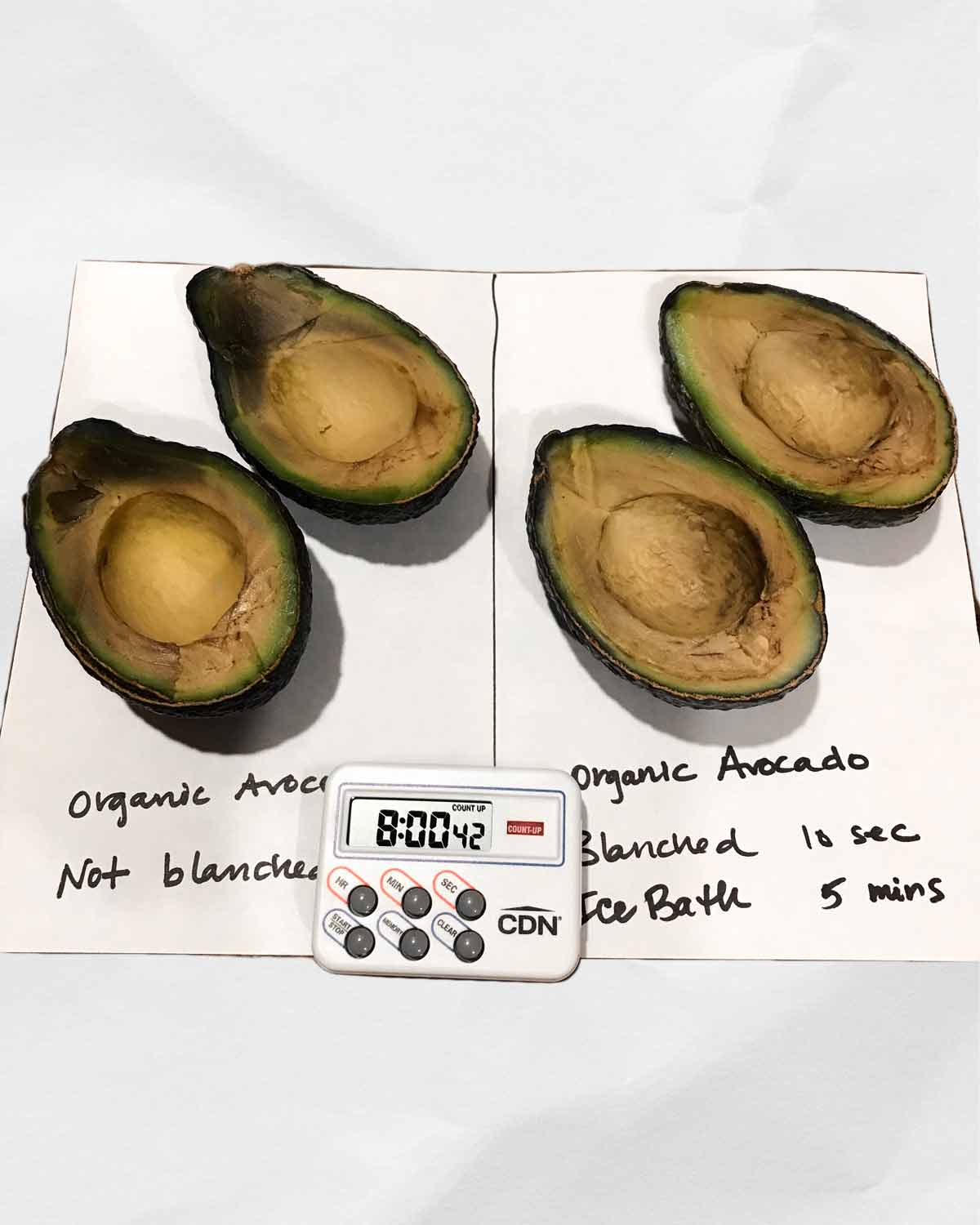
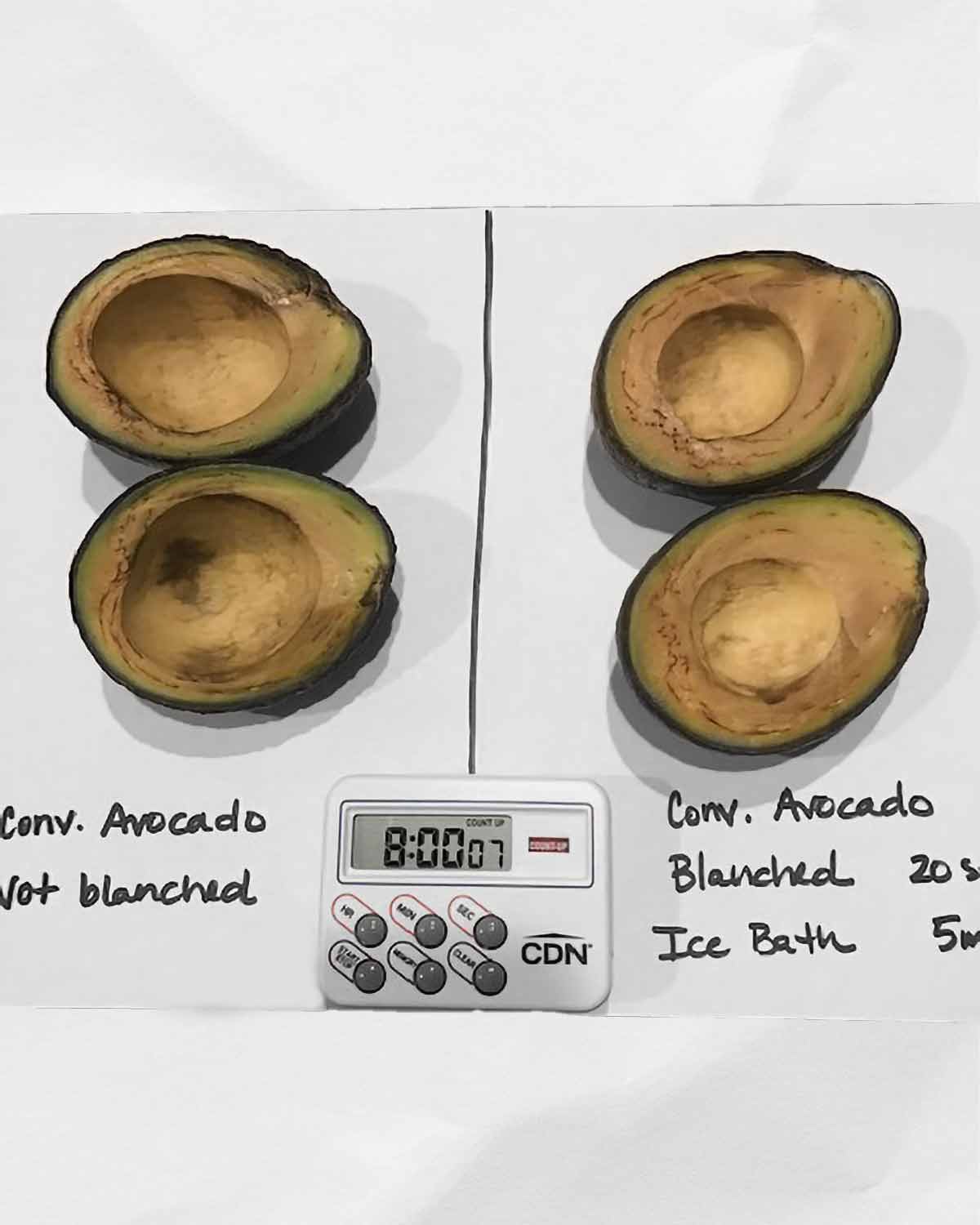

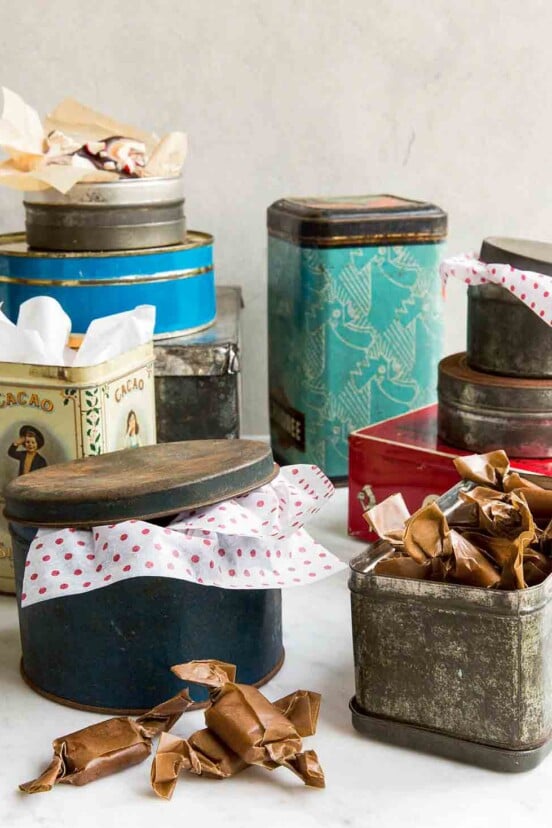










What is this “leftover half of an avocado” thing you mentioned.
Dear Bkhuna,
I rarely have leftover avocado – simply because I can’t resist chowing down on it. That said, I realize there are some (and by “some” I mean those more disciplined than me) capable of using part of an avocado and then storing the rest to be devoured later.
So this last week, my husband decided to buy two bags of avocados for pickup at WallyWorld — 14 of them. I love guacamole as much as the next person — no, MORE — but there are only two of us here and I HATE it when I have to toss them; it’s like burning money. On my FB feed (how DO they KNOW???) came something that said to scoop out the green and mash it up and put it on a tray in the freezer, then several hours later pick up the scoops and put them in a plastic bag in the freezer to await your thawage. Five days later they are lovely and green and frozen in my freezer. I will let you know how they come out after I make guac on Super Bowl Sunday. (Go, Chiefs!)
Dear Shauna,
Okay, you’ve got my attention! We didn’t test freezing avocados and I’m curious to know about their texture post thawage. Please let us know how they come out.
I make guacamole in large batches, press it into ice cube trays, and freeze it. Then I pop it out and store in either a zippy bag or a container. It thaws just fine, with no loss of texture. Haven’t tried freezing just plain avocado. Another way of storing avocados is to peel, slice and then plop them in a jar with a salt-water brine and a tad of lemon juice. Works pretty well.
Nice tips, Dona! Thank you!
Okay: I wasn’t sure about the thawing process and I didn’t want to leave avocados just sitting on the counter to turn brown. I basically piled all the fixings for guacamole on top of them to keep them from oxidizing as they thawed. After I did it, I realized that all those ingredients were going to make it hard to know what texture was the avocado and what was the lime juice, onion, garlic, etc. You’re the food scientist— you do the double blind test!!? But our guacamole was tasty and I didn’t notice that there was anything off. here’s the pic
Hi Shauna,
Guacamole success! I love it. You have inspired me. I’m going to try freezing some avocados down the road. Thank you for letting us know how it turned out.
Jennifer, what would happen if you peeled the halved avocado, then blanched it? Just wondering what that would do both to the fruit and to the enzyme on the peeled/cut sides. Inquiring minds want to know (without sacrificing my own avocado, that is!)
Hi Dona K,
Interesting question. We didn’t blanch peeled avocados. My fear is that the fruit would cook and become mushy. Anyone ever tried this?